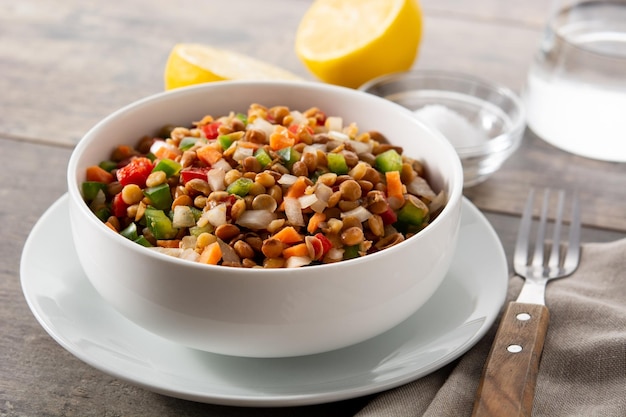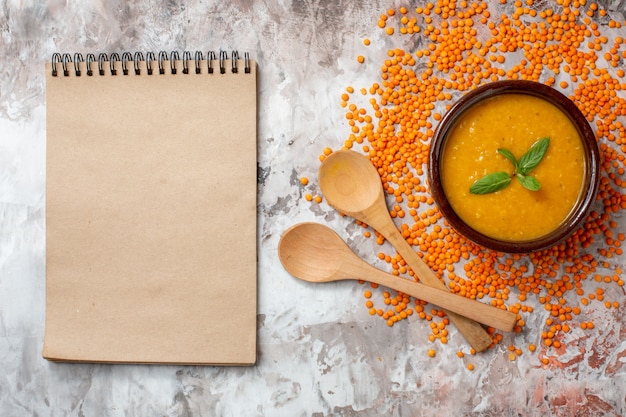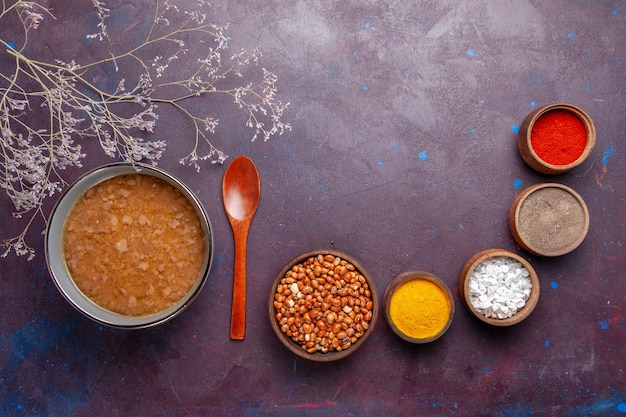Lentils, those unassuming little legumes, hold a special place in my heart. They've been a constant companion in my kitchen, adding hearty protein and satisfying fiber to countless meals. But let's be honest, mastering the art of cooking lentils, especially getting them to that perfect texture, can feel like a culinary puzzle sometimes. You might have faced the dreaded mushy lentil situation, or those frustratingly hard little guys that just haven't quite reached their peak.
Fear not, fellow lentil enthusiasts! This guide aims to demystify lentil cooking, revealing the secrets to achieving flawlessly cooked lentils, every single time. We'll embark on a journey through the different types of lentils, delve into their cooking times, and explore a treasure trove of tips and tricks to elevate your lentil game. So, grab a comforting cuppa, settle in, and let's unravel the magic of lentils together.
(Part 1) Unveiling the Wonders of Lentils: A Family of Flavors

The lentil world is a diverse one, boasting a variety of shapes, sizes, and colors, each with its unique personality and culinary purpose. Understanding these differences is key to unlocking the best results in your lentil dishes. Let's meet the main players in this fascinating legume family:
1. The Classic brown lentils: A Versatile Staple
Brown lentils are the most common and readily available type. They hold their shape beautifully during cooking, making them ideal for robust soups, hearty stews, and even salads where a bit of texture is desired. You'll often find them in brown, green, or black varieties, with the green lentils being slightly firmer, holding their shape better than the brown ones.
2. The Delicate french lentils: A Soft and Creamy Touch
These little beauties, often called French lentils, are known for their gentle texture and subtle flavor. They tend to break down during cooking, creating a smooth and velvety consistency, perfect for creamy soups and dips. Their diminutive size and delicate nature also add a touch of elegance to dishes.
3. The Elegant red lentils: A Quick Cook with a Subtle Sweetness
Red lentils, often referred to as "split red lentils," have been split and had their outer skins removed. This unique processing makes them cook incredibly quickly, sometimes in as little as 15 minutes. They have a slightly sweet flavor and break down easily, making them perfect for curries, hearty stews, and even lentil loaf where a smooth texture is essential.
4. The Exquisite black lentils: Earthy Delights with a Firm Bite
Black lentils, sometimes called "beluga lentils" due to their resemblance to the prized caviar, possess a unique earthy flavor and maintain a firm texture even after cooking. They hold their shape beautifully, making them an excellent choice for salads, side dishes, and as a hearty addition to grain bowls.
5. The Versatile Green Lentils: A Touch of Firmness and Bite
Green lentils, sometimes referred to as "French lentils" (though they are distinct from the delicate French lentils mentioned earlier), offer a slightly firmer texture compared to their brown counterparts, holding their shape well during cooking. They are a delightful choice for salads, hearty soups, and robust stews, adding a pleasant texture and a hint of bite.
(Part 2) The Art of Cooking Lentils: A Step-by-Step Guide to Perfection

Now that we've met the lentil family, let's dive into the art of cooking them to perfection. Here's a step-by-step guide to ensure your lentils reach their full potential, yielding a delicious and satisfying result:
1. The Rinse and Sort Ritual: Ensuring Purity and Flavor
Begin by giving your lentils a good rinse under cold running water to remove any lingering debris or impurities. While you're at it, take a moment to sort through them, gently picking out any small stones or imperfections. This simple step, though often overlooked, ensures a clean and flavorful final dish.
2. The Perfect Pot: Choosing Your Culinary Vessel
A good pot is essential for successful lentil cooking. I personally prefer a heavy-bottomed pot with a lid, as it distributes heat evenly, minimizing scorching and promoting even cooking. A trusty dutch oven is a fantastic option for larger batches and hearty stews, while a saucepan is perfectly suitable for smaller quantities.
3. The Water to Lentil Ratio: A Balanced Equation for Tenderness
The general rule of thumb for water to lentil ratio is 3:1. This means for every cup of lentils, you'll use three cups of water. However, this ratio can vary slightly depending on the type of lentil and your desired texture. For example, red lentils, known for their quick cooking time, might require slightly less water to achieve your desired consistency.
4. The Simmer Symphony: Gentle Cooking for Flavor and Texture
Bring your lentil mixture to a boil over high heat, then reduce the heat to a gentle simmer. Cover the pot with a lid to retain moisture, creating a steamy environment that encourages even cooking and allows the lentils to soften beautifully. This simmering stage is crucial, allowing the lentils to absorb the flavors of the surrounding broth while developing their tender texture.
5. The Taste Test: A Culinary Compass for Perfect Texture
Once the lentils have reached a tender consistency, they're ready to be enjoyed. However, a quick taste test is always a good idea. Ensure the lentils are cooked through but still retain a slight bite, a sign of perfect tenderness. If they feel too mushy, continue cooking for a shorter time or add a touch more water to adjust the texture.
(Part 3) The Secrets of Cooking Time: A Detailed Guide for Each Lentil Type

Let's delve into the specifics of lentil cooking times, providing a detailed guide to help you achieve the perfect texture for each type of lentil.
1. Brown Lentils: A Steady Cook for Versatile Dishes
Brown lentils typically require a simmering time of 20-30 minutes to reach their perfect tenderness. You'll know they're ready when they are tender yet still maintain their shape. For a firmer texture, suitable for salads or dishes where a bit of bite is desired, cook them for 20 minutes. For a softer texture, perfect for soups or stews, cook them for 30 minutes.
2. Green Lentils: A Bit More Firm for Hearty Dishes
Green lentils, like their brown cousins, benefit from a good simmer. They typically take about 25-35 minutes to cook through. They'll be ready when they are tender but still retain a slightly firmer texture, providing a satisfying bite. For a firmer texture, cook them for 25 minutes. For a softer texture, cook them for 35 minutes.
3. French Lentils: A Softer Touch for Creamy Dishes
French lentils are known for their delicate texture, breaking down easily during cooking. They typically take about 15-20 minutes to cook. For a creamy texture, perfect for soups and dips, cook them for 15 minutes. For a slightly firmer texture, cook them for 20 minutes.
4. Red Lentils: The Quick Cook for Smooth Dishes
Red lentils are the speedsters of the lentil world, cooking incredibly quickly. They're ready in a mere 15-20 minutes. For a slightly firmer texture, suitable for lentil salads or curries, cook them for 15 minutes. For a smooth and creamy texture, perfect for stews or lentil loaf, cook them for 20 minutes.
5. Black Lentils: Maintaining Their Shape for Hearty Bites
Black lentils, with their firm texture, require a slightly longer cooking time than red lentils, but they are still relatively quick. They are ready in about 20-25 minutes. For a firmer texture, ideal for salads or side dishes, cook them for 20 minutes. For a softer texture, suitable for lentil stews, cook them for 25 minutes.
(Part 4) Unleashing the Flavor: Enhancing Your Lentils with Aromatics, Spices, and Herbs
Now that we've mastered the technical aspects of lentil cooking, let's delve into the art of flavor enhancement, transforming ordinary lentils into extraordinary dishes. Here are some tips and tricks to elevate your lentil game to new heights:
1. The Aromatic Symphony: Building a Flavorful Base
Start by sautéing some aromatic ingredients in a little oil or butter. Classic choices include onions, garlic, and ginger, but don't hesitate to experiment with others like leeks, shallots, or even celery. These aromatics will infuse your lentils with depth and complexity, creating a richer and more flavorful broth.
2. The Spice Rack: Adding Depth and Complexity to Your Dishes
Spices are your secret weapon for transforming simple lentils into extraordinary dishes. Curry powder, cumin, coriander, turmeric, and paprika are just a few examples of spices that can add vibrant and complex flavors to your lentil creations. Experiment with different spice blends to discover your favorites.
3. The Herb Garden: Freshness and Finesse for Aromatic Delights
Fresh herbs like parsley, cilantro, mint, or thyme can add a touch of freshness and aromatic brilliance to your lentil dishes. Add them towards the end of cooking to preserve their vibrant flavors and create a burst of freshness.
4. The Liquid Boost: Stocks and Broths for Savory Depth
Instead of plain water, consider using a flavorful broth or stock to elevate your lentil dishes. Chicken, vegetable, or even beef broth will infuse your lentils with deep savory notes, adding complexity and richness to the final dish. Feel free to experiment with different flavor combinations, like a tomato broth or a coconut milk broth for a unique and delicious twist.
5. The Texture Tweak: Adding Crunch and Interest for a Multi-Sensory Experience
To add texture and interest to your lentil dishes, consider incorporating toasted nuts, seeds, or chopped vegetables. Toasted walnuts, pumpkin seeds, or sunflower seeds provide a delightful crunch and a boost of healthy fats. Chopped fresh vegetables, like bell peppers, carrots, or zucchini, add a welcome burst of color and flavor.
(Part 5) The Creative Lentil Journey: Diverse Recipes and Applications for Every Taste
Lentils are incredibly versatile, lending themselves to a multitude of culinary creations. Let's explore some exciting lentil recipes and applications that showcase their versatility:
1. The Classic lentil soup: A Comforting Staple for Any Season
Lentil soup is a timeless comfort food, perfect for a chilly evening or a cozy lunch. It's warm, satisfying, and incredibly easy to make. Simply sauté some onions, garlic, and carrots, then add lentils, broth, and your favorite spices. Simmer until the lentils are tender, and enjoy a bowl of comforting goodness.
2. The Vibrant Lentil Salad: A Refreshing Delight for Warm Weather
Lentils are a perfect addition to salads, adding protein, fiber, and a satisfying texture. Combine cooked lentils with chopped vegetables like cucumber, tomato, bell pepper, and red onion. Dress the salad with a tangy vinaigrette, and enjoy a refreshing and nourishing meal.
3. The Hearty Lentil Stew: A Warm Winter Embrace for Cozy Evenings
Lentil stew is a perfect winter warmer, ideal for chilly evenings or cozy gatherings. Combine lentils with root vegetables like potatoes, carrots, and celery. Add a flavorful broth, spices, and herbs for a hearty and satisfying stew that warms the soul.
4. The Exotic lentil curry: A Flavorful Adventure for Spice Lovers
Lentils are a staple ingredient in many Indian curries, adding a creamy texture and a nutty flavor to these complex dishes. Combine red lentils with onions, garlic, ginger, and spices like turmeric, cumin, and coriander. Add coconut milk for a creamy and aromatic curry that's sure to transport you to a flavorful paradise.
5. The Creative Lentil Loaf: A Meatless Marvel for Vegetarian Delights
Lentils are a wonderful base for lentil loaf, a vegetarian alternative to traditional meatloaf. Combine cooked lentils with chopped vegetables, breadcrumbs, and seasonings. Shape the mixture into a loaf, bake until golden brown, and enjoy a hearty and satisfying main course.
(Part 6) The Storage Secret: Preserving Your Lentils for Future culinary adventures
After cooking, store your lentils in an airtight container in the refrigerator for up to 3-4 days. You can also freeze cooked lentils for up to 3 months. To freeze, simply place the cooked lentils in a freezer-safe bag or container.
(Part 7) The Lentil Journey: Personal Reflections and Tips from a Seasoned Lentil Lover
My journey with lentils has been a delightful one, filled with culinary discoveries and satisfying meals. From simple lentil soups to elaborate lentil curries, they've always been a reliable and flavorful ingredient. Over the years, I've learned a few tricks that have made my lentil cooking experience even more enjoyable.
Firstly, always check the expiry date on your lentil bag. This ensures that you're using fresh lentils for the best flavor and texture. Secondly, don't be afraid to experiment with different spices and flavors. Lentils are a blank canvas for creativity, so let your imagination run wild.
Finally, remember that lentils are a hearty and nutritious ingredient that can be enjoyed in countless ways. Embrace their versatility, and enjoy the wonderful world of lentil cooking.
(Part 8) The Lentil Cookbook: Recommended Resources for Inspiration and Culinary Exploration
For those seeking even more lentil inspiration, here are some excellent resources to expand your lentil repertoire:
- "The Lentil Cookbook: Simple, Delicious and healthy recipes" by Robin Robertson - A comprehensive guide featuring a wide range of lentil recipes, perfect for both beginners and experienced cooks.
- "The Complete Vegetarian Cookbook" by Tess Challis - This book offers a wealth of vegetarian recipes, including many lentil-based dishes, perfect for those exploring meatless options.
- "The Vegetarian slow cooker Cookbook" by America's Test Kitchen - This book provides slow-cooker recipes for lentil stews, soups, and other comforting dishes, perfect for effortless meal preparation.
(Part 9) FAQs: Common Lentil Questions Answered with Expert Insights
1. Can you eat lentils raw?
While lentils are safe to eat raw, they are quite hard and difficult to digest. It's always best to cook lentils thoroughly before consuming them to ensure proper digestion and enjoyment of their flavor and texture.
2. How do you know when lentils are cooked?
When lentils are cooked, they should be tender but still have a slight bite to them. If they're too mushy, they've been overcooked. You can also check the lentils by pressing on them with a fork. If they easily give way, they're done.
3. What happens if you overcook lentils?
Overcooked lentils tend to become mushy and lose their shape, sometimes becoming slightly sticky and difficult to eat. If you've overcooked your lentils, don't worry! You can still use them in dishes like soups or stews where texture isn't as critical.
4. Can you reuse cooked lentils?
Yes, you can definitely reuse cooked lentils. They can be stored in an airtight container in the refrigerator for up to 3-4 days. You can use them in salads, sandwiches, soups, or as a side dish.
5. What are some good ways to use leftover lentils?
Leftover lentils are incredibly versatile. Here are a few ideas:
- Add them to a salad for a protein boost and satisfying texture.
- Make a hearty lentil soup or stew, perfect for a comforting meal.
- Use them as a base for a lentil loaf, a delicious vegetarian main course.
- Combine them with rice or quinoa for a nourishing and flavorful grain bowl.
- Spread them on toast for a quick and easy snack, packed with protein and fiber.
(Part 10) The Lentil Legacy: A Culinary Adventure Continues
As you embark on your lentil culinary journey, remember that there's no right or wrong way to cook them. It's all about exploring, experimenting, and finding what works best for you. Let your creativity guide you, and enjoy the delicious and satisfying world of lentils. They're a versatile and nutritious ingredient that can add a touch of magic to your culinary creations. Happy lentil cooking!
Everyone is watching

How to Cook Frozen Lobster Tails Perfectly: A Step-by-Step Guide
RecipesLobster. Just the word conjures up images of lavish meals, special occasions, and a taste of luxury. But let's...

Pigs in a Blanket Cooking Time: How Long to Bake for Perfect Results
RecipesAh, pigs in a blanket. Just the name conjures up images of those delightful little parcels of crispy pastry en...

Pork Fillet Cooking Time: How Long to Cook It Perfectly
RecipesPork fillet, or tenderloin as it's sometimes called, is a real favourite in our house. It's so versatile, and...

The Ultimate Guide to Cooking Delicious Frankfurters
RecipesLet's face it, we all love a good frankfurter. It's a classic, simple, and always satisfying. But let's be rea...

The Ultimate Guide to Tender, Juicy Pulled Pork
RecipesRight, let's talk pulled pork. It's one of those dishes that just screams "comfort food," doesn't it? I mean...
